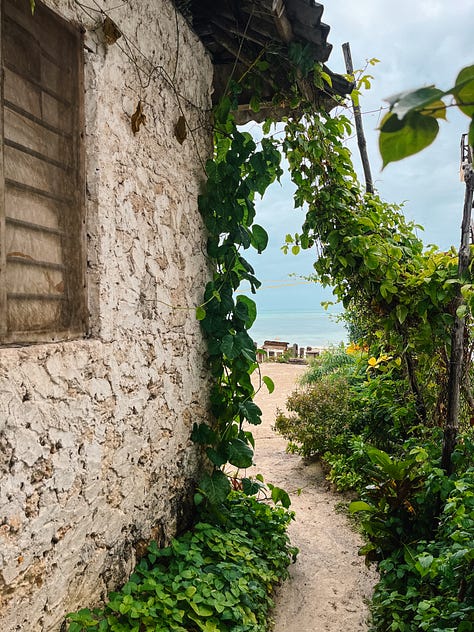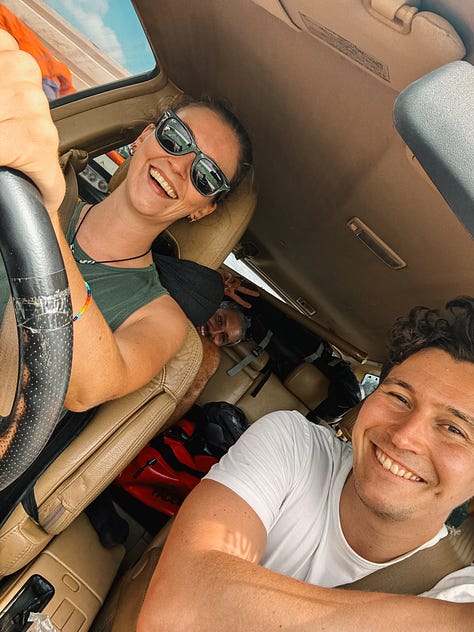This is the third and final part to our drive around Tanzania. We arrived in Zanzibar by ferry from Dar Es Salam, docking at the old harbour in Stone Town, next to the Freddie Mercury bar. If you’re a Queen fan you probably already know that Freddie was born in Stone Town, Zanzibar, to Parsi-Indian parents. For some reason our expectations of Zanzibar were pretty low. I think we expected it to be a place void of character and completely ruined by tourism, but we spent a whole three weeks driving around the island and proving ourselves wrong. While you do find endless souvenir shops selling “Hakuna Matata” t-shirts, you also don’t have to look too hard to find the truly authentic side of the island. We were definitely positively surprised by what Zanzibar had to offer - and it’s an absolute paradise for cat perverts like myself…







What’s really cool about walking through the streets of Stone Town is the fact that on every street corner you can see reminders of their past. Omanis, Portuguese, Indians, British, even the Persians have left their marks on Zanzibar. The famous Zanzibar doors are clues to their trade relationships with regions like India and the Arab world. There’s a Hindu temple in the old town that was established to cater for the many Hindus who had come over with the Sultan of Oman in the early 1800’s to fill key administrative positions like port managers and heads of customs and ended up settling there. The influence of Persian architecture is seen in “Shirazi building styles” (the Persians tried to colonise Zanzibar at one stage), and even the name Zanzibar itself is most likely derived from the Persian “Zangi-bar” meaning “coast of the blacks”. So for anyone interested in history, Stone Town is full of it!




Zanzibar’s trade relationships were mostly related to spice, and at one stage Zanzibar was the centre of the global spice trade. It was the cloves that were the big hit and even until today Zanzibar is one of the world’s largest clove producers. We didn’t visit any of the spice farms, which is a popular day trip for tourists, but we did buy up bars of black clove soap at the old Darajani spice market in Stone Town - best soap ever, but makes your shower look like you’ve been washing with bog water. Of course there’s also a dark side to the history of Zanzibar… Stone Town was home to the world’s last open slave markets, it was only shut down by the British in 1873! The slave market memorial and the exhibition were really worth the visit, and seeing the “holding cells” where the women and children were kept was fairly chilling…

I couldn’t talk about Zanzibar without mentioning one of our favourite guesthouses we stayed in. It is located on the beach in Pingwe in the east and is owned by an 80 year old lady by the name of Carol, or as the locals call her “Bibi Mrembo” (beautiful grandmother). Bibi is originally from the US but spent most of her life living in Germany with her German husband. He died in 2019 and in 2020 when the covid lockdown happened in Germany, Carol couldn’t think of anything worse than isolating there alone. She packed up her bags and headed for Tanzania, where covid restrictions were much more lenient, and it was there in Zanzibar that she found a plot of land with nothing only a ruin on it. With the help of a local (foreigners cannot outright own property in Tanzania) Bibi was able to take over the ruin and renovate it into her home, which doubles as a guesthouse. The guesthouse has three bedrooms, and the rest is common space shared with Bibi. Bibi is so chatty and full of life, she swims in the ocean every day, and she spends time chatting with travelers and sharing her life story with them. We enjoyed her company SO much, she really was such an inspiring lady. Find me another 80 year old woman who would pack up her life and move across the world to live at the beach so she can sea swim every day!








Our good friend Christoph joined us in Zanzibar towards the end of December and travelled with us for three weeks from Zanzibar to Malawi. While Zanzibar was all about beach, food, snorkeling, and chilling, we headed back towards the mainland for safari in Mikumi National Park. Christoph’s only dream was to see a lion and boy did Mikumi deliver. Not only did we see plenty during the game drive, we even met some on the road while driving to our camp the evening before. Fun fact: lions eat 50kg of meat at a time and then they don’t eat again for another 5-7 days - that’s literally how long it takes them to digest the meat.





The distances are so huge in Tanzania and we ended up doing a lot of driving between Mikumi and the area where we spent Christmas (read here about where we spent Christmas). We made a stop halfway in the mountainous town of Iringa. It is also a former German colonial town, but there’s not a whole lot to do there other than enjoy a really cool prehistoric site on the outskirts of town. It’s a dramatic landscape of stand stone pillars, and it was here in the late 1950s that archaeologists unearthed one of the most significant Stone Age finds ever identified. Tools found at the site – hammerstones, axeheads, flints and scrapers – are estimated to be between 60,000 and 100,000 years old. Definitely worth the visit!




And with that we left Tanzania on December 26th and entered Malawi. We’ll tell you about Malawi very soon…
That’s the final part to our drive around Tanzania. Next up, Malawi…
Thanks for reading Postcards from Africa - we really enjoy sharing our adventure with you. Don’t forget to subscribe, if you haven’t already!













Can’t wait for warm heart of Africa